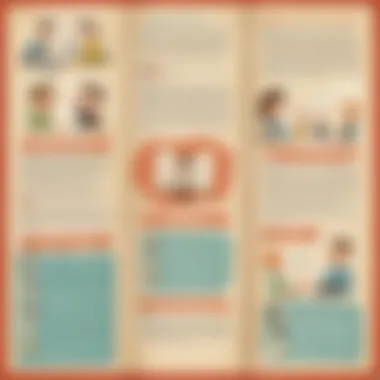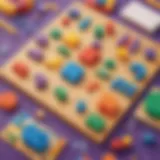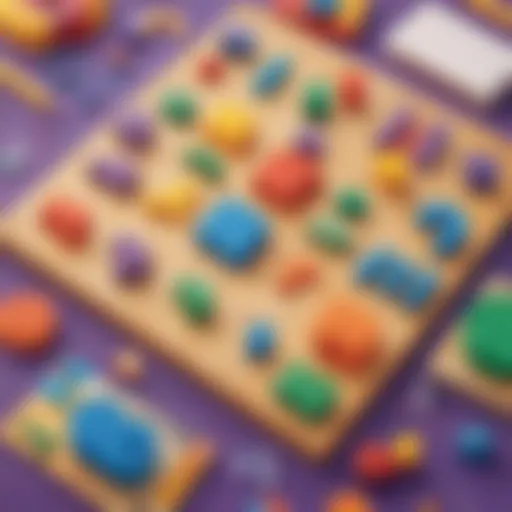Understanding Sentences: The Key to Effective Communication


Intro
Sentences form the backbone of communication. They are not just mere collections of words, but organized structures that convey thoughts, ideas and emotions. Exploring these components helps us grasp language more effectively. In this guide, we will delve into the anatomy and function of sentences, making the information clear for young learners, parents and caregivers alike.
Children's understanding of sentences is key to better communication. This knowledge is vital across various contexts, from daily chats to academic pursuits. Equipped with the tools to construct and deconstruct sentences, learners can become more confident in expressing themselves.
"Understanding sentences can enhance literacy skills and communication clarity."
Throughout the following sections, we will investigate sentence structure, types, and significance, thus cementing the foundation of language learning. Let’s embark on this journey!
Creative Activities
Engaging kids in hands-on activities can make the study of sentences enjoyable and memorable. Here are some ideas:
Craft Ideas
- Sentence Blocks: Create colorful blocks, each with a word. Mix and match to form different sentences. This helps in visualizing sentence structure.
- Sentence Road: Draw a simple road on paper. Use cards with various words and let children strategize how to arrange them for coherent sentences.
Step-by-Step Guides
- Constructing Sentence Blocks:
- Creating a Sentence Road:
- Gather small pieces of cardboard.
- Write a different word on each block, focusing on verbs, nouns and adjectives.
- Encourage children to stack blocks to form sentences.
- Draw a long winding road.
- Place word cards along the road and ask kids to pick them up to form a sentence at each stop.
Educational Value
These activities provide a multi-sensory experience. Crafting aids in better retention through visual and tactile learning. Furthermore, they promote critical thinking as children try different word combinations.
Fun Quizzes
Quizzes are a fun way to reinforce what children learn about sentences.
Quiz Topics
- Types of sentences: declarative, interrogative, exclamatory, imperative.
- Identifying sentence components: subjects and predicates.
Question Types
- Multiple choice questions can gauge understanding.
- Fill-in-the-blank questions ensure recall of specific words or patterns.
Knowledge Reinforcement
Quizzes provide instant feedback and encouraging results builds confidence in sentence construction. Revisiting topics through quizzes cements knowledge while keeping learners engaged.
Fact-Based Articles
Fact-based articles enrich the learning experience with diverse insights.
Topics
- The importance of punctuation in sentences.
- How historical figures interacted through letters, forming sentences.
Engaging Content
These articles are written in an accessible style. Simple explanations break down complex ideas, catering to young minds seeking clarity.
Preamble to Sentences
Understanding sentences is a fundamental step in grasping the English language. Sentences form the building blocks of communication, enabling individuals to share thoughts, convey information, and connect with one another. This article, by exploring the structure and function of sentences, aims to guide young learners and their caregivers through the intricate world of language mechanics.
Proper knowledge of sentences does not just enhance communication skills but also boosts overall comprehension. When children learn about sentences, they develop a sense of how language can be constructed to serve various purposes, from asking questions to making declarations. This framework turns the act of writing from a daunting task into a more manageable and engaging activity.
What Is a Sentence?
A sentence is a group of words that express a complete thought. It consists of a subject, which indicates who or what the sentence is about, and a predicate, which explains what the subject does or what is being said about it. To put it simply, a sentence tells us something.
For example, in the sentence "The cat sleeps," "The cat" is the subject, while "sleeps" is the predicate. This structure enables us to convey clear messages, allowing readers and listeners to easily understand the intended meaning.
Every sentence begins with a capital letter and ends with punctuation. Common punctuation marks include periods, question marks, and exclamation points, each serving to illustrate the tone of the sentence.
Importance of Sentences in Language


Sentences are the cornerstone of effective communication. They allow us to construct ideas, ask questions, and deliver commands. Mastering the art of sentence construction aids learners in honing their writing and speaking skills.
Consider some key reasons why sentences are essential:
- Clear Messaging: Sentences help clarify thoughts, making understanding easier.
- Engagement: Structured sentences capture the audience’s attention better than disorganized words.
- Expression of Ideas: Well-formed sentences give us the ability to express sentiments ranging from joy to disbelief.
- Educational Significance: Understanding sentences is central to developing reading and comprehension skills.
Ultimately, learning about sentences opens up a world of possibilities, connecting ideas and emotions in unique ways.
Basic Components of Sentences
Understanding the basic components of sentences is crucial for young learners. It provides a foundation for effective communication. By grasping these foundational elements, students enhance their writing skills and language consciousness.
Subjects and Predicates
Every sentence has two main parts: the subject and the predicate. The subject tells us what or whom the sentence is about, while the predicate reveals something about the subject. For example, in the sentence "The cat (subject) is sleeping (predicate)," the focus is on 'the cat' and what it is doing.
This binary structure not only guides students in forming correct statements but also helps them assess all components of their own sentences. A strong subject makes the statement clear, adding firm direction to the idea being conveyed. Conversely, the predicate communicates the action or state of being, supplying vital detail.
Fundamentally, understanding subjects and predicates encourages learners to craft complete sentences, preventing confusion that may arise from partial expressions.
Punctuation: The Silent Guide
Punctuation plays a vital yet often underestimated role in sentence construction. It organizes thoughts and clarifies meaning in a sentence. For instance, a period indicates the end of a statement, while a question mark conveys inquiry.
Understanding punctuation marks can minimize misunderstandings. Some key punctuation marks to consider include:
- Commas: Indicate pauses or separate items in a list.
- Periods: Mark the end of a statement.
- Exclamation Points: Show strong feelings or emphasis.
- Question Marks: Indicate a question is being asked.
Each mark serves a specific purpose that strengthens written language. Without punctuation, sentences may warp into confusing fragments lacking cohesion.
Types of Sentences
Understanding the different types of sentences enhances not only language mechanics but also the way we communicate. Each type has its distinct function, making sentences effective tools in expressing thoughts. By knowing how to use these types right, both young learners and their mentors can improve their communication skills.
Declarative Sentences
Declarative sentences are used to make statements. They provide information in a straightforward manner. Generally, these sentences end with a period. It’s important for children to recognize declarative sentences because this type forms the basis of most information sharing.
A well-structured declarative sentence is key to effective communication.
Example:
- The dog is barking.
This sentence states a fact, making it useful in communication.
Key Characteristics:
- States information clearly
- Usually asserts a fact or opinion
- Ends with a period
Interrogative Sentences
Interrogative sentences ask questions, drawing out needed information from others. They are essential in discussions, especially for young learners developing inquiry skills. Specialized interrogatives often start with words such as who, what, where, when, and why.
Example:
- What is your favorite book?
This sentence looks for information, showing its function in communication.
Key Characteristics:
- Invites a response
- Begins with question words
- Ends with a question mark
Imperative Sentences
Imperative sentences give commands or requests. They shape interactions and encourage action responding to the environment or instruction. Recognizing this form is important for order and structure in educated dialogue.
Example:
- Please close the door.
This imperative directs a specific action, showcasing its practical utility in communication.
Key Characteristics:
- Commands or requests
- Often have an implied subject of 'you'
- Can end with a period or exclamation mark for emphasis
Exclamatory Sentences
Exclamatory sentences express strong feelings or emotions. They resonate deeply and typically end with an exclamation mark. While they are less frequent than other types, these sentences boost expressive capabilities in discussions.


Example:
- What a beautiful day it is!
Such sentences serve to amplify the feelings behind the expression, enriching communication.
Key Characteristics:
- Convey strong emotion
- End with an exclamation mark
- Capture moments of excitement or surprise
Constructing Effective Sentences
Building effective sentences is essential for clear communication. Sentences serve as the building blocks of language, shaping how information is conveyed. Effective sentence construction ensures audience comprehension, emphasizing the importance for young learners in developing their language skills. Clarity and structure in this area translate into successful interactions in daily life.
Clarity and Brevity
Maintaining clarity in sentences is crucial for effective communication. A sentence should deliver a message without confusing the reader. Here are some key ideas to improve clarity:
- Use simple words. Avoid jargon or overly complex phrases. Young readers can better understand clear language.
- Keep to the point. Remove unnecessary words that do not add meaning, which enhances brevity.
- Be specific. A clear sentence answers questions like who, what, when, where, and why clearly.
When brevity is achieved alongside clarity, the resulting impact is strong. For example, the sentence, 'The cat ran fast,' is straightforward. If changed to, 'The enormous furry cat with stripes hurried quickly through the fields,' it introduces unnecessary complexity. Avoid long sentences. Instead, break them up into shorter sentences when possible.
”Concise language invites engagement, while wordiness often alienates.”
Variety in Sentence Structure
While clarity and brevity hold significance, variety in sentence structure also matters. Mixing types of sentences adds interest to a discussion or narrative. Consider these aspects:
- Simple Sentences: Ideal for beginning a topic. 'The sun is shining.' This creates an uncomplicated statement open to further elaboration.
- Compound Sentences: They connect one idea with another. 'The sun is shining, and the birds are singing.' This allows thoughts to enhance each other.
- Complex Sentences: They show relationships between ideas. For example, 'Though it was raining, the children played outside.' Such sentences encourage exploration of diverse thoughts.
Incorporating a variety of sentence structures encourages readers to remain engaged. It can also strengthen the message’s overall impact, appealing to the audience’s interest. When constructing effectively, ensure that each element contributes to clarity and maintains fluid meaning.
Function of Sentences in Communication
Sentences serve as fundamental building blocks of our communication. Their importance transcends mere grammar, influencing how we connect with others, share knowledge, and express our feelings. When we construct sentences, we create clear pathways for conveying thoughts and emotions. This section details the pivotal functions sentences serve in effective communication, showcasing their role in interaction.
Conveying Information
One primary function of sentences is to convey information. They allow us to share facts, opinions, and ideas with clarity. In everyday contexts, sentences helped clarify the complexities of our world. For example, consider a simple statement: "The sun rises in the east."
Such sentences provide concrete information. They extrapolate observations into digestible knowledge. This clarity often forms the basis of learning and understanding in children. Effective sentences help minimize confusion, cementing the shared understanding necessary for learning.
Sentences can facilitate understanding in numerous ways. Here are specific aspects related to conveying information:
- Clarity: Well-structured sentences provide direct meanings.
- Concision: Short, to-the-point sentences prevent unnecessary length in conveying facts.
- Contextualization: Information is placed within a wider context, aiding comprehension.
In the educational context, teachers often use declarative sentences to outline lessons clearly, ensuring children grasp the material. These thoughtfully crafted statements enhance learning experiences.
Effective communication begins with clarity in information shared through sentences.
Expressing Emotions
Sentences also play a vital role in expressing emotions. They allow individuals to articulate their feelings. Whether through excitement, sorrow, or passion, sentences carry personal sentiments. Such emotional expressions build connections between people.
Consider the difference between a plain statement and one loaded with feeling.
- A straightforward statement, "I lost my keys," lacks depth.
- In contrast, saying, "I feel frustrated because I can't find my keys," adds emotional depth.
Thus, sentences transform dryness into relatability. Proficiency in utilizing emotional sentences cultivates higher emotional intelligence, crucial in developing empathy among children.
Some aspects to note include:
- Tone: The words chosen can drastically change sentence meaning and emotional weight.
- Intensity: Choosing more emotional words increases the strength of expressions.
- Context: Knowing when to share emotions keeps communication authentic.
By fostering emotional literacy, we help children learn to use sentences that enrich personal interactions. Teaching the use of emotion-laden sentences will contribute to the development of deeper social bonds.
Sentences in Educational Contexts
Importance of Sentences in Education
Sentences play a crucial role in education. They help students understand language, develop critical thinking, and communicate effectively. Mastering the structure and function of sentences is essential for reading comprehension and writing skills. Students who grasp these concepts are better equipped for academic success and everyday communication.
Enhancing Reading Skills
To enhance reading skills, understanding sentences is indispensable. Each sentence builds the framework of a text by conveying meaning and creating coherence. When students learn to interpret sentences correctly, they improve their overall reading ability. Sentence complexity can indicate various writing styles and genres. Recognizing simple, compound, and complex sentences enriches readers' comprehension.


Benefits of Sentence Awareness in Reading
- Context Clues: Sentences provide hints and insights related to the text.
- Inference: Understanding how sentences connect allows readers to infer meaning beyond the written words.
- Fluency: Familiarity with sentence structures promotes smoother reading.
- Engagement: Clear sentences stimulate interest and encourage deeper examination of texts.
Practice Through Writing
Writing practice is vital for students to internalize the mechanics of sentences. When they write, students apply sentence concepts and experiment with their use. This hands-on experience reinforces learning and enhances creativity.
Methods to Practice Sentence Writing
- Journals: Encourage students to keep writing journals to express daily thoughts.
- Prompt Challenges: Provide various prompts to stimulate creative sentence construction.
- Peer Review: Use peer editing exercises to analyze sentence structures within classmates' work.
- Word Games: Engage students with word games focusing on sentences to build sentence variance.
Writing helps solidify the understanding of the sentence's role in communication and fosters a community of eager learners ready to express themselves clearly.
By understanding how to construct and deconstruct sentences, students not only enhance their reading and writing but also empower themselves to convey ideas more effectively.
Practical Applications of Sentences
The practical applications of sentences are crucial to understand how language operates in everyday life. This section defines their importance, focusing on the elements that enable clear communication and encourage comprehension among young learners.
Everyday Communication
Everyday communication involves how we convey our thoughts with sentences all around us. From short news alerts to long discussions, the way we structure our sentences makes a significant impact. Use of simple or complex sentence plays a vital role in clarity.
Using concise sentences is effective in daily situations. People use sentences every day without even noticing. For example, conversations at home, in schools, or even through text messages all rely heavily on sentences. Clarity remains a priority. Here are some key elements:
- Clarity: A well-structured sentence ensures the message is understood.
- Brevity: Short sentences can be more impactful, especially when providing information.
- Tone: The tone expressed in sentences can influence emotions. A warm tone may create friendly interaction.
Consider this brief quote: > “Clarity is the key to communication.” A sentence embodies this idea, making it easier for listeners to grasp the intended message
Creating effective sentences varies with context. Children learn this through interaction. Simple tasks like ordering food, engaging in play, and expressing needs, enhances their skills. Young minds start to realize how effective sentences lead to connection.
Creative Writing and Storytelling
Creative writing and storytelling expand beyond everyday phrases. Here, sentences build worlds, express feelings, and interact with readers. These sentences serve various purposes helping to engage the audience.
In storytelling, the arrangement of sentences dramatically shapes narrative pacing. Well-structured sentences with details engage the reader. Following are key aspects of both:
- Imagination: Creative sentences stir the imagination. Strong verbs and unique phrasing add depth.
- Structure: The rhythm of sentences must align with tension and emotion. Dialogue often differs from narration in style. Dialogues need sentence variety, producing intrigue.
- Themes and Motifs: Repeated sentence patterns can reinforce a narrative theme. For instance, a repetitive phrase can create mood or focus.
Effective creative writing impacts young readers. They begin to think about how sentences can generate excitement or suspense. Learning that sentences possess power enchances overall appreciation for language. Encour یہ address engages learning, contributing indirectly to their overall skills.
Common Mistakes in Sentence Construction
Understanding the common mistakes in sentence construction is essential for anyone looking to improve their writing skills and communicate clearly. Sentences are the building blocks of language, and even minor errors can change meanings or confuse the reader. Recognizing these common pitfalls helps both learners and experienced writers alike to enhance their abilities and convey ideas more effectively. By avoiding these mistakes, writers create smoother reading experiences and promote better comprehension.
Run-On Sentences
Run-on sentences occur when two or more independent clauses are incorrectly joined without appropriate punctuation or conjunctions. For example, if someone writes, "I love to read books I go to the library often," the reader might struggle to understand the intended meaning because the ideas run together without proper separation.
Here are some key aspects to consider about run-on sentences:
- Identify and correct: Recognizing a run-on sentence involves looking for places where clauses can stand alone but are connected improperly. A quick fix is often to insert periods or conjunction words.
- Use punctuations wisely: Commas and conjunctions play a vital role. Using a comma along with a coordinating conjunction like “and,” “but,” or “or” improves sentence flow.
- Varied length and structure: Short, concise sentences can be effective, and using a mix of short and longer sentences makes writing more dynamic.
- Examples: A correct version of the earlier run-on example is: "I love to read books. I go to the library often." Such minor adjustments can greatly enhance clarity.
Tip: Always double-check your sentences. A simple reading can help catch run-ons before finalizing your work.
Fragmented Sentences
Fragmented sentences, or sentence fragments, do not express a complete thought because they lack essential components such as a subject or a predicate. An example would be the phrase, "Because I enjoy the weather." This does not provide sufficient information on its own. Although fragments may seem acceptable in casual speech or when creating a certain style in creative writing, they can lead to misunderstandings in formal contexts.
Consider these important aspects about fragmented sentences:
- Recognize the missing elements: Identify what is missing. A fragment often lacks either a subject, a verb, or a complete idea. Common fragments include dependent clauses or phrases tried to stand alone.
- Fixing fragments: To correct a fragment, writers need to add the missing components to form a complete sentence. For instance, "Because I enjoy the weather, I often go outside to sit in my garden." This gives full context.
- Read aloud: Sometimes reading your sentences out loud can help to catch fragments quickly. A complete thought should sound clear when spoken.
Common mistakes in sentence construction like run-ons and fragments can affect writing abilities in both young learners and seasoned authors. By understanding these issues and applying corrections, one can enhance their overall communication skills efficiently.
Closure
The conclusion plays a vital role in wrapping up the insights provided in this article about sentences. It synthesizes the information, reiterating key elements in a clear manner. The main benefit of a strong conclusion in any educational material is that it reinforces the learning outcomes. Here, it consolidates the knowledge acquired across different sections involving sentence structure, types, and functions.
Summary of Key Points
In this article, we have explored various aspects of sentences:
- Definition and Importance: Understanding what sentences are and recognizing their significance in language is foundational.
- Components: We discussed subjects, predicates, and punctuation, which are essential for forming coherent sentences.
- Types: The distinction between declarative, interrogative, imperative, and exclamatory sentences shows the range of expression available.
- Construction: Good construction hinges on clarity, brevity, and variety.
- Communication Role: Sentences serve to convey information, express emotions, and facilitate learning in educational contexts.
- Practical Uses: From everyday conversation to creative writing, the applications of sentences are numerous.
- Common Errors: Recognizing mistakes like run-on and fragmented sentences helps in developing better writing skills.
Encouragement for Further Exploration
To deepen understanding, it is essential to look beyond mere sentence structure and function. I encourage readers to explore the associative nature of complex sentences, play with sentence remodeling, and practice different writing styles. Engaging with different types of literature can also broaden one's view of sentence variety and creativity.
In practical settings, children can benefit from writing exercises that challenge their skills. Ultimately, exploring sentences should be embraced as an ongoing journey rather than a destination. Sentences are more than just grammar; they are the building blocks of thoughts and communication that shape our daily lives. This invitation to further explore can ignite a passion for language that lasts a lifetime.







